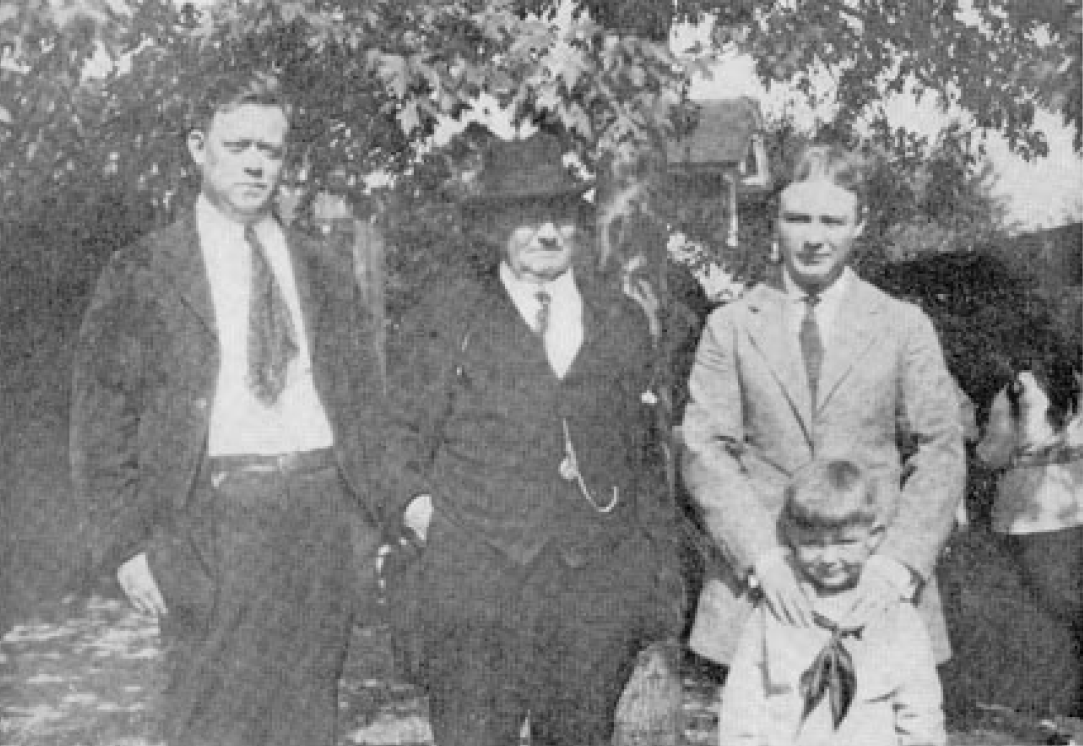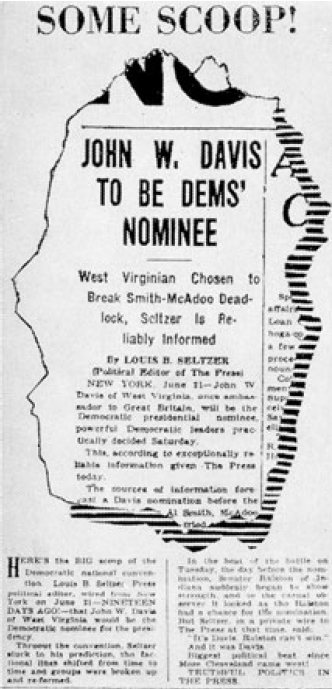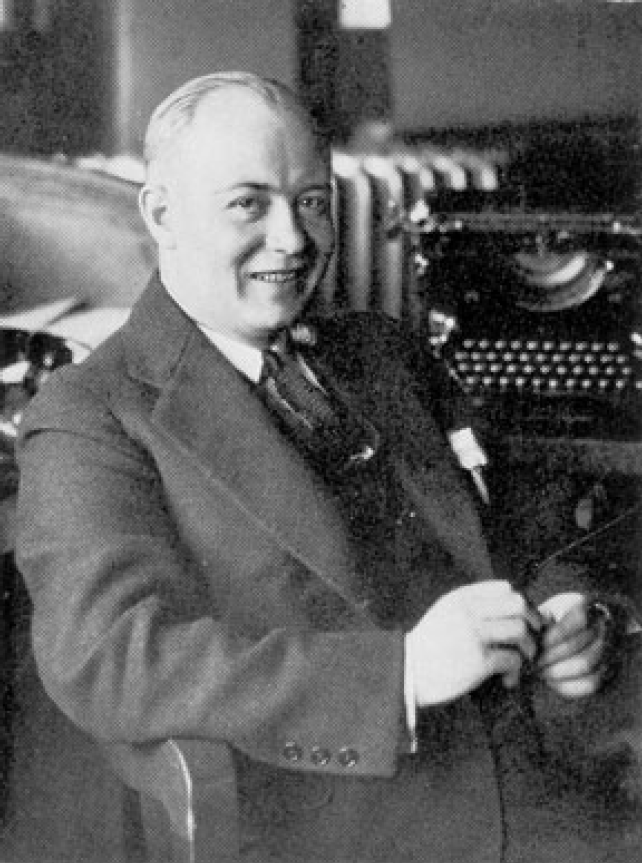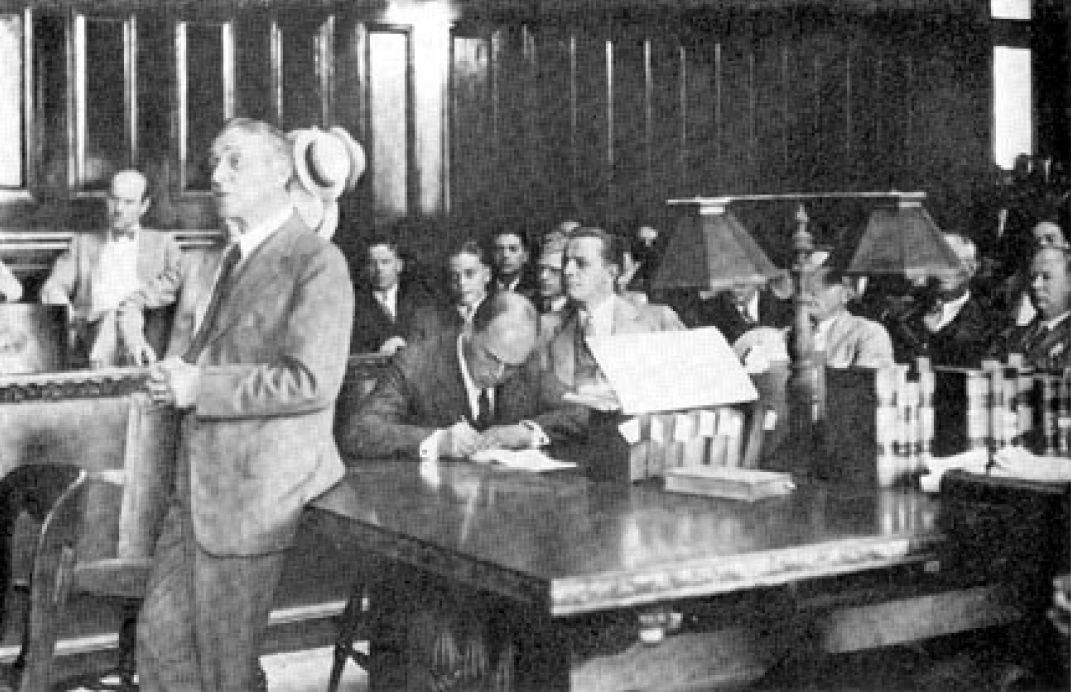Main Body
Chapter 12
ON JULY 4, 1919, it looked as if all of America had converged upon Toledo, Ohio. That was the occasion, as sports fans no doubt remember, of the classic battle between Jess Willard and Jack Dempsey for the heavyweight championship of the world. There wasn’t a hotel room to be had for any price in the whole town. Everything had been solidly booked for months in advance.
For days people had been sleeping on benches, on blankets in the parks, on porches all around the town. Many of them had to walk miles to lay their heads on a porch swing or a hammock. It was not unusual to see a fastidiously dressed gentleman — complete with traditional diamond stickpin, stiff cuffs, and shimmering cravat, even in the broiling heat of July — reclining on somebody’s porch, for a price, to catch his night’s sleep.
Transportation of any kind was at a premium, if not unobtainable. Hotel lobbies were impossible to get into, and, once in, it almost cost your life, and certainly bruises and shin-cracking, to get out again. For color, for excitement, for tension, for wide-open betting with odds fluctuating wildly, for confusion and chaos, nothing else I have ever seen even remotely equaled that event.
The lean, trim, hard-looking, then flat-nosed Jack Dempsey was at once surrounded by great throngs whenever he appeared anywhere. He couldn’t even move more than a few steps. The same was true of big, genial, towering Jess Willard, who appeared singularly shy for a man so widely acclaimed as a world champion.
The facilities for covering such a great story in 1919 were vastly different from those of today. Television did not exist. Radio was not yet practicable. The “broadcast” was just beginning, and the few sets in use were mostly of the “oatmeal box” kind — so called because they were made with the tuning coil wound around the outside of oatmeal boxes picked off pantry shelves. Movies were being taken, but they would not be exhibited until days later. The immediate coverage of the fight on that July 4, 1919, was strictly up to the newspapers.
Almost the whole staff of The Cleveland Press, far smaller in 1919 than it is today, was called into action — either at the office, handling the fight as it came through, or on the scene at the vast, improvised Bay View Park Arena in Toledo where the great sports event was taking place. It was our job to make sure that our paper would be out first and out in front in dispatches, in color stories, and in pictures. The stories could be telephoned or wired, but getting the pictures back in those days took careful, intricate planning.
At that time we had three photographers. All were sent to Toledo to take pictures of the fight. With them were sent three reporters assigned to act as couriers for bringing the plates straight from the camera back to Cleveland by plane or automobile. The first pictures into Cleveland from the fight had a financial as well as a news value. The paper that got them out first was bound to see many thousands of extras.
It would take several hours, no matter how fast we worked, to get the pictures in from Toledo, process them, and get them into the “Fight Extra.”
Arrangements of an infinite variety had to be made, for transportation, for the housing of photographers and reporters, and, far more important than all else, for the seats at the fight itself. I was to go to Toledo several days in advance to make these arrangements on the scene for our staff.
We went out to sprawling Bay View Park Arena three days before the fight to spot our locations and to “case” the place so that every step and every minute of time could be planned. Time was the most important element with which we were confronted. We arranged that one photographer was to take from his particular position the action in the first round. He was instantly to give his plates to the reporter who would be sitting right at his elbow, and that reporter was to make a dash — his exit was also carefully expedited — to either car or plane. The other two photographers were to cover the second and third rounds in the same way. All three photographers were then to stay at the scene for the full fight, so that on the following day The Press would have complete pictorial coverage.
We were among the hundreds who had no rooms. One of our reporters had friends living in Toledo who graciously turned over their front porch to us. It was a stifling night, and with no pillows, and nothing whatever to ease the hard floor of the porch, sleeping was out of the question.
The day of the fight was one of the hottest days of that summer. The event was scheduled for afternoon, but before daybreak people started for the Bay View Park Arena. They paid whatever the asking price might be for whatever food was available. Many, like us, had had no sleep. Most walked to the scene of the fight.
The place was literally packed, but luckily our seats were well toward the ring. They had to be. Cameras in 1919 were not the amazingly effective instruments, equipped with powerful telescopic lenses, that they are today. They were cumbersome, box-like affairs, much harder to handle.
My seat was an enviable one, close to the Dempsey side of the ring, but I was not there to watch the great fighter in action. I was located where I could see, signal to the photographers, and check on the exit of the couriers. The fight for us was incidental. Our obligation was to get the pictures and put them on their way as fast as was humanly possible to Cleveland.
The fight began. Our pictures of the first round were taken. The plates were handed to the first courier, and he went on his way. I watched to make sure he got out of the fight arena. The second round came up, and the process was repeated.
In the third round Dempsey came out of his corner like a ferocious animal, and battered the big Willard all over the ring. It didn’t seem possible for the fight to last very long, and we had to be prepared for that, also. I directed the third courier, who was originally supposed to take off immediately with pictures of the third round, to stay until the fight was over — until the knockout picture, which would be the most important picture of all, was taken.
I sent the courier to the nearest exit — ready to race to his car as soon as the plate was handed to him — and I took his place at the side of our photographer.
The third round was over. The bell rang for the fourth round. Willard, bloody, battered, and beaten, did not come out. The fight was over. The photographer shot a picture of the referee holding up Dempsey’s right hand, handed the plate to me, and I raced to the courier at the exit — getting knocked down twice on my way to him. Away he went.
My part in the great event was over, but it would be some hours before I knew the results back in Cleveland. It was impossible to call the office. Telephones and telegraph wires were pre-empted by the prior claims of sports writers telling the dramatic story to their newspaper offices all over the country. Together the last photographer — Louis Van Oeyen –and I made our way to Cleveland by train, the only means of transportation left since our cars and planes had been used by the couriers.



appointed Editor of The
Cleveland Press (1928)

(seated far right) (1929)
For several hours, as the train moved at what we thought was a snail’s pace, we didn’t know what had happened back home — whether the carefully worked-out plans of many weeks, and the hectic action of that afternoon, had given the paper a great picture scoop, or whether, by some unexpected turn, we had been beaten.
When we got off the train at Cleveland we saw our “Fight Extra” — and there were the pictures displayed all over Page One. That was pleasant reassurance. The pictures had come through, and they were good. But the big question remained unanswered. We raced up the street from the railway depot.
Nobody had to tell us that The Press had scored a “beat.” Every face in the office, though tired and perspiring, was beaming — an eloquent enough answer to our anxious question.
We were happy that night at The Cleveland Press — that July 4, 1919. The Dempsey-Willard fight was an unforgettable sports spectacle for the thousands who were fortunate enough to jam Bay View Park Arena that afternoon. It was perhaps even more unforgettable for the newsmen who prepared so meticulously to overcome the many obstacles which no longer — in this techno-scientific age of newspaper pictures — are faced in our business.
Looking back upon it there is no doubt that we overstaffed, over arranged, overspent to set up every precaution and make sure we’d come through with the big scoop. But we did it, and that was what counted. We couldn’t afford to do otherwise. And today, although the circumstances are altogether different, the same spirit prevails at The Cleveland Press, and at all other newspaper offices all over America. You do what you have to do in the time and under the circumstances where, and when, it is called for. The newspaper business has from the beginning been one in which enterprise, initiative, ingenuity, resourcefulness, and audacity have been combined to produce results. It requires these today — even more, if anything, in competition with science’s modern instantaneous communications — than ever before.
There is only one Dempsey-Willard fight in a lifetime, and it happened in the times when sweat, effort, initiative, and hurdling of tough obstacles made the big scoop a tremendous newspaper exploit. There were other big “Special Extras” after the Dempsey-Willard fight, but not many and surely none so dramatic. Eventually, the great newspaper extra yielded to radio’s ability to reach people faster with the flash news upon which the extra had been based. The public scarcely realized it when the extra faded from the American scene. There were no obsequies, no ceremonies, no regrets. But there is still nostalgia in the hearts of newspapermen who taxed their ingenuity to the utmost to rush the news into print — and who felt perhaps the greatest thrill of their lifetime when the cry of “Extra, Extra” rose on the streets and they knew they had scored a beat.
